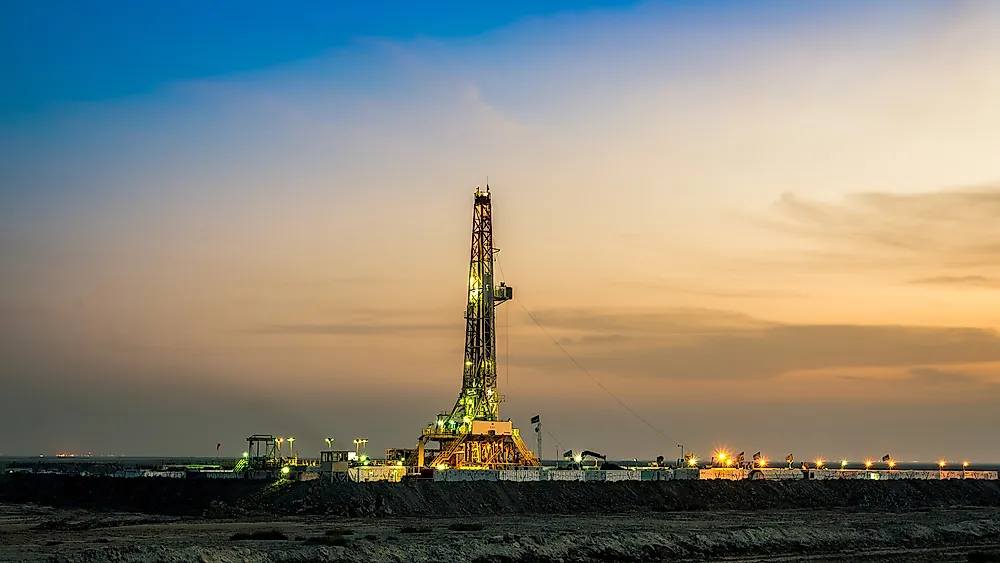Natural Resources of Iraq

The Republic of Iraq is a western Asia country bordering Turkey, Iran, Kuwait, Saudi Arabia, Jordan, and Syria. It is home to a variety of ethnic groups with the majority of the population being Arabs.
The economy of Iraq is dominated by the oil sector which accounts for about 95% of the foreign exchange earnings. Most of the other sectors remain underdeveloped resulting in 18-30% unemployment rate. The public sector is the main employer, accounting for almost 60% of full-time employment. The oil industry, which is a major economic driver in the country, generates very little employment. Iraqi’s main natural resource is petroleum, but the country also has abundant sulfur, phosphate, and natural gas. The economy is also based on agriculture, with farmers depending largely on irrigation in the dry-desert like the climate in the country.
Petroleum
Iraq has some of the largest oil reserves in the world. It has over 143 billion barrels of proven reserves. As of 2012, Iraq produces 3.4 million barrels of oil per day from the 2,000 oil well already drilled. In the 1970s, Iraq produced slightly more barrels per day, but the sanctions imposed against the country in 1990 following their invasion of Kuwait significantly affected the oil sector. It was prohibited from exporting oil until 1996, leading to an 85% decline in the output. Although the sanction was lifted in 2003, the ongoing conflicts have hampered the development of oil resource in Iraq. The decades of war and unrest has brought about uncertainty about the oil reserves in the country. The US Department of Energy estimates that Iraq has 112 billion barrels while the US Geology Survey estimates 78 billion barrels.
Natural Gas
The Middle East accounts for about 43% of the world’s natural gas, with an estimated 2,835 trillion cubic feet (tcf) of natural gas reserves. However, many researchers believe that the prospect of natural gas reserves in the country could be as high as double the current estimates. Natural gas reserves in Iraq are mainly found in areas close to the oil reserves. In 2013, gas production in Iraq reached 2.23 billion cubic feet per day with the southern fields producing 1.9 billion cubic feet. However, the ongoing conflicts have reduced production to only 700 million cubic feet per day both from the north and south fields.
Phosphate
The Middle East is a well-known phosphate region. However, phosphate reserves in Iraq are not as popular as other reserves in the same region. The phosphate deposit in the country is part of the Tethyan Phosphate Belt and are hosted by the Eocene, Paleocene, and Late Cretaceous sedimentary rocks flanking the Ga’ara uplift. Iran has 22 reported phosphate occurrence of phosphate, with all the reserves located in the country’s western region.
Sulfur
Sulfur deposits are mainly found in the Al Mishraq mines located in the southeast of the city of Mosul in the Ninawa Governorate. The deposits are mainly mined by the Mishraq Sulfur State Corporation. The country has an estimated 600 million tons of native sulfur with the MSSC expecting to produce 0.5 million tons per year once the necessary facilities are put in place. Currently, the deposit produces about 340,000 metric tons per year.
Agricultural Land
Although Iraq is mainly dry throughout the year, agriculture still plays a major role in the development of the economy. As of 2014, approximately 12% of the total land area is under agriculture. The fertile alluvial plains along the banks of Euphrates and Tigris are important agricultural regions and are under intensive farming. However, farmers in other areas use the irrigation system to counter the dry desert-like climate. Iraq’s primary agricultural products include rice, wheat, and barley. Additionally, the country also produces a significant percentage of the world’s dates.











